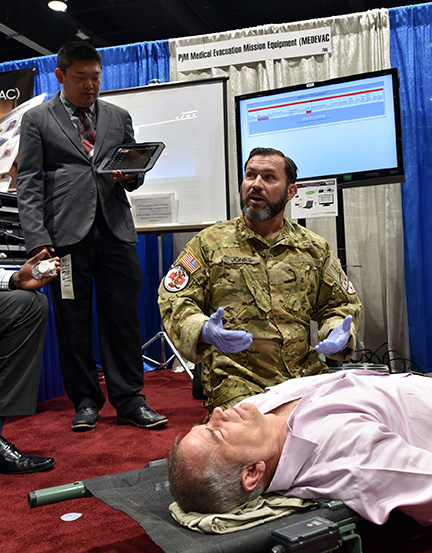'Dust Off' Demos Showcase Army Medical Evacuation Modernization

As a crowd gathers, Army Transport Telemedicine Product Manager Jay Wang starts off by setting the scene.
"Imagine you are a medic on the battlefield and you just pick up six of your wounded battle buddies for a casualty evacuation. You are busy trying to save their lives and get them to the next level of care, which is a nearby field hospital that has no idea how many patients you are bringing or their conditions," Wang explained to attendees of the Military Health System Research Symposium in Kissimmee, Florida, Aug. 27-30. As the only scientific meeting addressing the unique medical needs of the Warfighter, the MHSRS draws in thousands of military scientists, academia and industry from around the globe annually to exchange information on research and health care advancements.
"What is our current technology for sharing information about trauma care on the battlefield?" Wang asked rhetorically, holding up a bloodied paper Tactical Combat Casualty Care card.
Wang and his team then demonstrate a solution they are developing at the U.S. Army Medical Materiel Agency, a subordinate organization of the U.S. Army Medical Research and Materiel Command. The system is called Medical Hands-free Ultra-wideband Broadcast, or MEDHUB, and it is designed to capture, store and forward data automatically from medical devices to receiving hospitals.
"The goal is to keep the medic or flight paramedic focused for performing life-saving tasks for multiple patients and remain unencumbered from documentation and reporting," said Wang.
The system's key components include individual wearable vital sign monitors that record vitals and provide littered or ambulatory status through accelerometers; peripherals to capture patient weight; and an end-user device, such as a tablet or phone, that captures and stores the data. Low band-width intensive data will be automatically sent ahead of the evacuation vehicle or aircraft on existing long-range DOD communication systems.
"The MEDHUB will provide the medics a powerful companion to help them capture, store and forward medical data that will improve patient safety, care and outcomes in all pre-hospital settings for both theater operations and consequence management response force operations," said Wang.
As the MEDHUB evolves, more than 5,000 Army medical ground ambulances and more than 600 Army air ambulances could be outfitted with the system, which is in advanced development at the USAMMA and on track to be fielded as early as 2020.
The USAMMA's MEDEVAC Mission Equipment Project Manager Lt. Col. Christian Cook has more than 20 years of experience as a pilot and said he knows firsthand the challenges of patient care on the battlefield. Hospital teams in the field often have limited information on the number of patients they are receiving and their conditions.
"A MEDEVAC aircraft may go out for one or two patients and come back with five or six," said Cook. "This makes it difficult for the hospital staff to plan for patient arrivals. Forwarding accurate patient counts, nature of injuries and vitals well ahead of arrival allow the gaining medical unit to alert and form the reception litter teams, anticipate the triage and assemble the right providers, such as specialists."
Currently, the MEDHUB concept is designed to autonomously send de-identified patient information to a display screen at the field hospital where clinicians can see what is inbound, including both the number of patients and their vital statistics.
"With this improved technology, we can provide better patient outcomes," explained Wang. "A faster flow of data will help the field hospitals better prepare immediate treatment plans and, ultimately, shorten the time it currently takes for an injured Service Member to receive critical life-saving care."
The tool could also be designed to support tools that have already been approved by the U.S. Food and Drug Administration, such as the Compensatory Reserve Index, which assist clinicians in quickly identifying and appropriately managing the most severely ill and injured patients. However, Wang clarified, the MEDHUB is not being designed to replace direct clinical care decisions by the medic or clinicians.
The MEDHUB concept was developed from user feedback from flight paramedics of all Army components, including flight paramedics stationed at the U.S. Army School of Aviation Medicine. The team is also working closely with the Army's Program Executive Office-Aviation.
In addition to the MEDHUB, the Project Manager MEDEVAC Mission Equipment symposium exhibit included several fielded MEDEVAC Mission Equipment products, such as the Interim MEDEVAC Mission Support System - Patient Handling System, which is employed in medical companies' air ambulances to provide a means of transporting or evacuating up to four patients who may be on stretchers or able to walk. The system includes seat pallets, seats, interior components and litter support.
Also displayed was a MEDEVAC Mission Sensor, Forward Looking Infra-Red, which is designed to help pilots and crew locate patients in limited visibility scenarios, such as nighttime and poor weather operations. Additionally, the displays included a Blackhawk Advanced MEDEVAC sliding window designed to provide crewmember critical external visibility of the tail rotor while keeping expensive and critical medical equipment within the aircraft.
"It is essential that we provide a better understanding to the entire medical community about our operational environment, as well as current and future MEDEVAC medical equipment package capabilities," said Lt. Col. Josephine Thompson, Medical Evacuation Product director, Utility Helicopter Project Office, PEO-Aviation.
Thompson, who attended the MHSRS, said that the user feedback has been very positive. For some people, however, the MEDHUB concept sounded a little too futuristic. Cook said that is why they wanted to show that the MEDHUB and other MEDEVAC equipment is available today at this year's symposium, which is the Department of Defense's premier medical scientific meeting.
"Some people thought this couldn't be done," said Cook. "So we are showing them that not only can it be done, but also that we are doing it."














